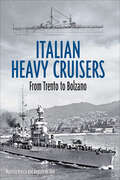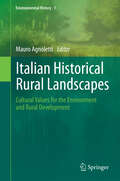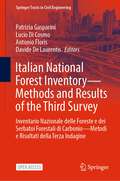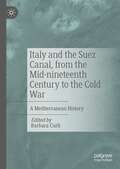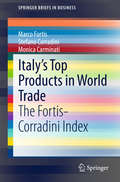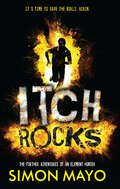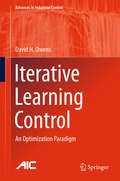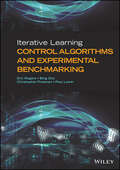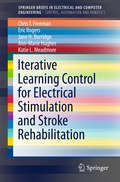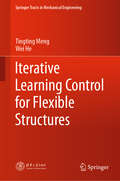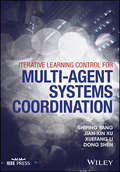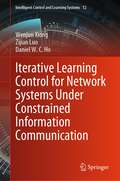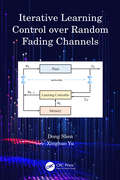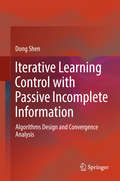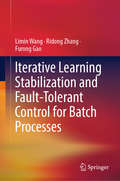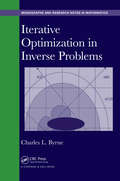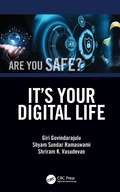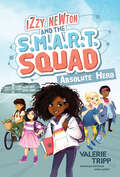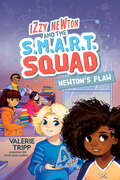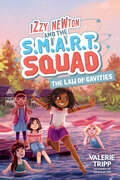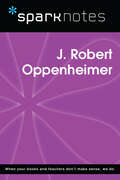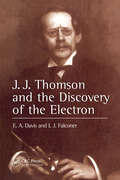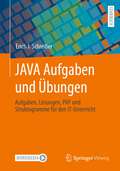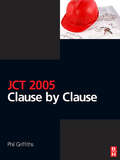- Table View
- List View
Italian Heavy Cruisers: From Trento to Bolzano
by Maurizio Brescia Augusto de ToroA technical history of seven Italian heavy cruisers: Trento, Trieste, Bolzano, Zara, Fiume, Gorizia, Pola—a perfect companion volume to Italian Battleships.When the Washington Naval Treaty of 1922 effectively banned the building of battleships, competition between the major navies concentrated on the next most powerful category, heavy cruisers limited to ten thousand tons displacement and eight-inch guns. Italy followed this trend, the first design for what became Trento and Trieste being ordered in 1924. These were the fastest of the first generation ‘Treaty’ cruisers but were very lightly armored, and the succeeding Zara class of four ships were slower but better protected. However, before the final ship of this class (Pola) had been completed, there was a return to the earlier fast, lightly protected concept with the Bolzano, although this ship also incorporated aspects of the Zara design. The political background, design history and technical features of these classes are covered in great depth in this volume. They were important ships, subject to incremental improvement so no two were identical, and model makers will appreciate the space devoted to the variations in appearance, using both description and illustration. As major units of the Italian battle fleet, they were more active than most during the war and their careers are fully detailed, including analyses of damage suffered. Tragically, they were all sunk, and the circumstance of each loss is explored. As befits a technical history, the book is thoroughly illustrated with ship and armament plans, detail drawings and color camouflage schemes, as well as an outstanding collection of photographs.
Italian Historical Rural Landscapes
by Mauro AgnolettiSustainable development and rural policies have pursued strategies where farming has been often regarded as a factor deteriorating the ecosystem. But the current economic, social and environmental problems of the Earth probably call for examples of a positive integration between human society and nature. This research work presents more than a hundred case studies where the historical relationships between man and nature have generated, not deterioration, but cultural, environmental, social and economic values. The results show that is not only the economic face of globalization that is negatively affecting the landscape, but also inappropriate environmental policies. The CBD-UNESCO program on biocultural diversity, the FAO Globally Important Agricultural Heritage Systems and several projects of the International Union of Forest Research Organizations, as well as European rural policies acknowledge the importance of cultural values associated to landscape. This research intends to support these efforts.
Italian National Forest Inventory—Methods and Results of the Third Survey: Inventario Nazionale delle Foreste e dei Serbatoi Forestali di Carbonio—Metodi e Risultati della Terza Indagine (Springer Tracts in Civil Engineering)
by Patrizia Gasparini Lucio Di Cosmo Antonio Floris Davide De LaurentisThis open access book deals with the methods and the results of the third Italian national forest inventory (INFC2015). Arma dei Carabinieri is entrusted with the realisation of the National Forest Inventory and with the decisions about the aims of the survey and data treatment. National forest inventories produce statistically based information on forests over country areas. Such information is used either at subnational or at supranational level in a great number of spheres and processes, included possibility to depict the status of the world forests. Italy conducted its first forest inventory in 1985 and in 2001 a permanent national forest inventory was launched to have periodically updated statistics. Due to the growing concern about the environment and especially the climate change, estimating forests carbon pools was a stated main objective and it was accordingly named Italian National Inventory of Forest and Forest Carbon Pools (INFC). The book begins with a description of the general organisation, the definitions, the methods and the estimation procedures. It proceeds showing the main estimates produced by INFC2015, in tables that are given in the book chapters. The estimates are presented through texts that introduce the subject matter, explain the way the related variables were surveyed and comment on the main outcomes with the help of graphics. The estimates presented include forest area, management and production, biodiversity and protection, forest health, protective and socio-economics functions. Role of forest in the carbon balance was analysed in a specific Chapter, as this is important for its role in the climate change mitigation. The book ends providing an understanding of the current dynamics of Italian forests by comparing the estimates obtained from INFC2005 and INFC2015, the last two national surveys.
Italy and the Suez Canal, from the Mid-nineteenth Century to the Cold War: A Mediterranean History
by Barbara CurliConceived in the 1850s and opened to navigation in 1869, the Suez Canal’s construction coincided with Italy’s path to unification and its first foray into nineteenth-century globalization. Since then, the history of Italy and the Canal have intertwined in many ways, throughout in peace and war. This edited collection explores the fundamental technical, diplomatic and financial contributions that Italy made to the production of the Canal and to its subsequent development, from the mid-nineteenth century to the Cold War. Drawing from unpublished public and private archival sources, this book is the first comprehensive account of this long and multifaceted relationship, providing innovative perspectives on Italy’s diplomatic, economic, social, colonial and cultural history. An insightful read for those studying maritime, diplomatic or Italian history, this book contributes to a growing body of research on the Canal, which has largely emerged from international business, labour and social history, and offers new insights into the Euro-Mediterranean region.
Italy's Top Products in World Trade
by Marco Fortis Stefano Corradini Monica CarminatiThis book analyzes Italy's external competitiveness in detail and introduces a new index, devised by Marco Fortis and Stefano Corradini for Fondazione Edison, that highlights the strengths of Italy's foreign trade. Compared with the Trade Performance Index compiled and updated annually by UNCTAD/WTO's International Trade Centre, the Fortis-Corradini Index (FCI) provides greater sectorial detail by referring to 5117 products identified according to the six-digit HS 1996 international classification available on the UN Comtrade database. The new index confirms that, contrary to widespread opinion, Italy is one of the world's most competitive countries, with an extraordinary position of leadership in world trade. Thus, according to the FCI, for 932 products Italy was either first, second or third worldwide in terms of foreign trade surplus in 2012. Furthermore, the FCI reveals, for example, that only three countries (China, Germany and the United States) surpassed Italy in 2012 in terms of the number of first, second and third places in their trade balance worldwide. In presenting the FCI and meticulous statistical data, this highly original study will be of wide interest.
Itch Rocks: The Further Adventures of an Element Hunter
by Simon MayoItchingham Lofte is back—and now hes the most protected boy in the world! After narrowly escaping the thugs from Greencorps and disposing of element 126, Itch and his family live under constant surveillance by Englands famed MI5. But even these top agents may not be able to help him when enemies old and new scheme to get their hands on the super-radioactive rocks—even if they have to kill Itch to do it. Filled with danger, thrills, and some shocking surprises, this suspenseful sequel is every bit as exciting as the first!
Iterative Learning Control
by David H. OwensThis book develops a coherent theoretical approach to algorithm design for iterative learning control based on the use of optimization concepts. Concentrating initially on linear, discrete-time systems, the author gives the reader access to theories based on either signal or parameter optimization. Although the two approaches are shown to be related in a formal mathematical sense, the text presents them separately because their relevant algorithm design issues are distinct and give rise to different performance capabilities. Together with algorithm design, the text demonstrates that there are new algorithms that are capable of incorporating input and output constraints, enable the algorithm to reconfigure systematically in order to meet the requirements of different reference signals and also to support new algorithms for local convergence of nonlinear iterative control. Simulation and application studies are used to illustrate algorithm properties and performance in systems like gantry robots and other electromechanical and/or mechanical systems. Iterative Learning Control will interest academics and graduate students working in control who will find it a useful reference to the current status of a powerful and increasingly popular method of control. The depth of background theory and links to practical systems will be of use to engineers responsible for precision repetitive processes.
Iterative Learning Control Algorithms and Experimental Benchmarking
by Christopher Freeman Eric Rogers Bing Chu Paul LewinIterative Learning CONTROL ALGORITHMS AND EXPERIMENTAL BENCHMARKING Iterative Learning Control Algorithms and Experimental Benchmarking Presents key cutting edge research into the use of iterative learning control The book discusses the main methods of iterative learning control (ILC) and its interactions, as well as comparator performance that is so crucial to the end user. The book provides integrated coverage of the major approaches to-date in terms of basic systems, theoretic properties, design algorithms, and experimentally measured performance, as well as the links with repetitive control and other related areas. Key features: Provides comprehensive coverage of the main approaches to ILC and their relative advantages and disadvantages. Presents the leading research in the field along with experimental benchmarking results. Demonstrates how this approach can extend out from engineering to other areas and, in particular, new research into its use in healthcare systems/rehabilitation robotics. The book is essential reading for researchers and graduate students in iterative learning control, repetitive control and, more generally, control systems theory and its applications.
Iterative Learning Control for Electrical Stimulation and Stroke Rehabilitation
by Chris T. Freeman Eric Rogers Jane H. Burridge Ann-Marie Hughes Katie L. MeadmoreIterative learning control (ILC) has its origins in the control of processes that perform a task repetitively with a view to improving accuracy from trial to trial by using information from previous executions of the task. This brief shows how a classic application of this technique - trajectory following in robots - can be extended to neurological rehabilitation after stroke. Regaining upper limb movement is an important step in a return to independence after stroke, but the prognosis for such recovery has remained poor. Rehabilitation robotics provides the opportunity for repetitive task-oriented movement practice reflecting the importance of such intense practice demonstrated by conventional therapeutic research and motor learning theory. Until now this technique has not allowed feedback from one practice repetition to influence the next, also implicated as an important factor in therapy. The authors demonstrate how ILC can be used to adjust external functional electrical stimulation of patients' muscles while they are repeatedly performing a task in response to the known effects of stimulation in previous repetitions. As the motor nerves and muscles of the arm reaquire the ability to convert an intention to move into a motion of accurate trajectory, force and rapidity, initially intense external stimulation can now be scaled back progressively until the fullest possible independence of movement is achieved.
Iterative Learning Control for Flexible Structures (Springer Tracts in Mechanical Engineering)
by Wei He Tingting MengThis book presents iterative learning control (ILC) to address practical issues of flexible structures. It is divided into four parts: Part I provides a general introduction to ILC and flexible structures, while Part II proposes various types of ILC for simple flexible structures to address issues such as vibration, input saturation, input dead-zone, input backlash, external disturbances, and trajectory tracking. It also includes simple partial differential equations to deal with the common problems of flexible structures. Part III discusses the design of ILC for flexible micro aerial vehicles and two-link manipulators, and lastly, Part IV offers a summary of the topics covered. Unlike most of the literature on ILC, which focuses on ordinary differential equation systems, this book explores distributed parameter systems, which are comparatively less stabilized through ILC.Including a comprehensive introduction to ILC of flexible structures, it also examines novel approaches used in ILC to address input constraints and disturbance rejection. This book is intended for researchers, graduate students and engineers in various fields, such as flexible structures, external disturbances, nonlinear inputs and tracking control.
Iterative Learning Control for Multi-agent Systems Coordination
by Jian-Xin Xu Dong Shen Shiping Yang Xuefang LiA timely guide using iterative learning control (ILC) as a solution for multi-agent systems (MAS) challenges, showcasing recent advances and industrially relevant applications Explores the synergy between the important topics of iterative learning control (ILC) and multi-agent systems (MAS) Concisely summarizes recent advances and significant applications in ILC methods for power grids, sensor networks and control processes Covers basic theory, rigorous mathematics as well as engineering practice
Iterative Learning Control for Network Systems Under Constrained Information Communication (Intelligent Control and Learning Systems #12)
by Daniel W. Ho Wenjun Xiong Zijian LuoThis book focuses on the subject area of Network Systems and Control Theory, providing a comprehensive examination of the dynamic behavior of networked systems operating under communication constraints. It introduces innovative iterative learning control strategies that aim to ensure stability, consistency, and security of networked systems. The field of networked systems has garnered significant interest from scientists and engineers across various disciplines, including information, electrical, transportation, life, social, and management sciences. This book consistently addresses a wide range of issues related to networked systems, emphasizing the critical impact of communication constraints on stability and security. It highlights the effectiveness and importance of iterative learning methods in tackling these challenges.Suitable for both undergraduate and graduate students interested in networked systems and iterative learning control, this book alsoserves as a valuable resource for university faculty and engineers engaged in complex systems, control theory research, and real-world applications. Its broad appeal extends to professionals working in related fields, seeking a deeper understanding of networked systems and their control mechanisms.
Iterative Learning Control over Random Fading Channels
by Xinghuo Yu Dong ShenRandom fading communication is a type of attenuation damage of data over certain propagation media. Establishing a systematic framework for the design and analysis of learning control schemes, the book studies in depth the iterative learning control for stochastic systems with random fading communication. The authors introduce both cases where the statistics of the random fading channels are known in advance and unknown. They then extend the framework to other systems, including multi-agent systems, point-to-point tracking systems, and multi-sensor systems. More importantly, a learning control scheme is established to solve the multi-objective tracking problem with faded measurements, which can help practical applications of learning control for high-precision tracking of networked systems. The book will be of interest to researchers and engineers interested in learning control, data-driven control, and networked control systems.
Iterative Learning Control with Passive Incomplete Information: Algorithms Design And Convergence Analysis
by Dong ShenThis book presents an in-depth discussion of iterative learning control (ILC) with passive incomplete information, highlighting the incomplete input and output data resulting from practical factors such as data dropout, transmission disorder, communication delay, etc.—a cutting-edge topic in connection with the practical applications of ILC. It describes in detail three data dropout models: the random sequence model, Bernoulli variable model, and Markov chain model—for both linear and nonlinear stochastic systems. Further, it proposes and analyzes two major compensation algorithms for the incomplete data, namely, the intermittent update algorithm and successive update algorithm. Incomplete information environments include random data dropout, random communication delay, random iteration-varying lengths, and other communication constraints. With numerous intuitive figures to make the content more accessible, the book explores several potential solutions to this topic, ensuring that readers are not only introduced to the latest advances in ILC for systems with random factors, but also gain an in-depth understanding of the intrinsic relationship between incomplete information environments and essential tracking performance. It is a valuable resource for academics and engineers, as well as graduate students who are interested in learning about control, data-driven control, networked control systems, and related fields.
Iterative Learning Stabilization and Fault-Tolerant Control for Batch Processes
by Furong Gao Limin Wang Ridong ZhangThis book is based on the authors’ research on the stabilization and fault-tolerant control of batch processes, which are flourishing topics in the field of control system engineering. It introduces iterative learning control for linear/nonlinear single/multi-phase batch processes; iterative learning optimal guaranteed cost control; delay-dependent iterative learning control; and iterative learning fault-tolerant control for linear/nonlinear single/multi-phase batch processes. Providing important insights and useful methods and practical algorithms that can potentially be applied in batch process control and optimization, it is a valuable resource for researchers, scientists, and engineers in the field of process system engineering and control engineering.
Iterative Optimization in Inverse Problems (Chapman & Hall/CRC Monographs and Research Notes in Mathematics)
by Charles ByrneIterative Optimization in Inverse Problems brings together a number of important iterative algorithms for medical imaging, optimization, and statistical estimation. It incorporates recent work that has not appeared in other books and draws on the author's considerable research in the field, including his recently developed class of SUMMA algorithms
It’s Your Digital Life
by Giri Govindarajulu Shyam Sundar Ramaswami Shriram K. VasudevanThis book intends to develop cyber awareness and technical knowledge in anyone who is interested in technology by looking at subjects and experiences the average person will have come into contact with in their life. This book aims to provide a complete and comprehensive analysis, technological inputs and case studies for the readers to build their awareness and knowledge, but in a meaningful way which will stay relevant. There are books available on the market, but they primarily discuss theory, and no industry connection or current state-of-the-art technology is presented. By discussing subjects and experiences that all readers will be familiar with, this book will aid understanding and comprehension of how cyber threats can be noticed, avoided and understood in everyday life. As well as case studies, this book also contains plentiful illustrations and supplementary videos, which will be available via YouTube to complement the information. Giri Govindarajulu is a Chief Information Security officer for Cisco Asiapac and is a 20-year Cisco veteran. Shyam Sundar Ramaswami is the Lead Threat Researcher with the Cisco Talos Threat Intelligence group. Shyam is a two-time TEDx speaker and a teacher of cybersecurity. Dr. Shriram K. Vasudevan is currently working as Dean of K. Ramakrishnan College of Technology. He has authored/co-authored 42 books for reputed publishers across the globe and 122 research papers in revered international journals, plus 30 papers for international/national conferences.
Izzy Newton and the S.M.A.R.T. Squad: Absolute Hero (Book 1)
by Valerie TrippWhen middle school mishaps happen, five friends form the S.M.A.R.T. Squad and use their collective skills and the power of science to bring order to their school.Science reigns supreme with this squad of young brainiacs. Join Izzy Newton and her friends in the first adventure of this fun new middle-grade fiction series from National Geographic Kids. A crowded new school and a crazy class schedule is enough to make Izzy feel dizzy. It may be the first day of middle school, but as long as her best friends Allie Einstein and Charlie Darwin are by her side, Izzy knows it'll all be okay. However, first-day jitters take an icy turn when Izzy's old pal Marie Curie comes back to town. Instead of a warm welcome, Marie gives her former pal the cold shoulder. The problems pile up when the school's air-conditioning goes on the fritz and the temperature suddenly drops to near freezing. The adults don't seem to have a clue how to thaw out the school. Cold temperatures and a frigid friendship? Izzy has had enough of feeling like an absolute zero. She rallies the girls to use their brainpower and science smarts to tackle the school's chilly mystery ... and hopefully to fix a certain frozen friendship along the way. Will the girls succeed and become the heroes of Atom Middle School?
Izzy Newton and the S.M.A.R.T. Squad: Newton's Flaw (Book 2)
by Valerie TrippWhen middle-school mishaps happen, five friends form the S.M.A.R.T. Squad and use their collective skills and the power of STEM to bring order to their school. Join Izzy Newton in the second adventure of this fun new fiction series, where science reigns supreme. With their first mystery solved and first-day jitters triumphantly behind them, Izzy and her pals---the Solving Mysteries and Revealing Truths Squad---start to settle in to the normal day-to-day at Atom Middle School. Izzy even works up the courage to try out for an all-boys sports team! Things are going well until a mysterious illness threatens to shut down the media center---and maybe the entire school. The S.M.A.R.T. Squad is on the case in a race to figure out what ails them. But that's not all. A pop-up science fair causes excitement and tension for the Squad. And Izzy's failure to speak up in her speech class feels like an obstacle she can't overcome. Can the girls pull together to solve the media center mystery? Will their STEM smarts help them rock the science fair? Or will Izzy Newton's flaws mean the end of the S.M.A.R.T. Squad? Plus, learn more about the real science behind the fiction and meet some amazing real-life scientists. Join award-winning author and American Girl series co-creator Valerie Tripp and the diverse, brilliantly brainy S.M.A.R.T. Squad gang in this charming second book in the series . And don't forget to check out the first book in the series, Izzy Newton and S.M.A.R.T. Squad: Absolute Hero. Praise for the series: It's one thing to have children's books about scientists or podcasts or stories about strong women in STEM, but it's another world entirely when your children get to feel represented by the characters they're reading about. -Romper
Izzy Newton and the S.M.A.R.T. Squad: The Law of Cavities (The S.M.A.R.T. Squad)
by Valerie TrippThe S.M.A.R.T. Squad is back to tackle more middle school mayhem with science, technology, engineering, math, and friendship! In this third book in the S.M.A.R.T. Squad series, best friends Izzy Newton, Allie Einstein, Marie Curie, Charlie Darwin, and Gina Carver set out on a mystery-filled outdoor adventure. Now that Izzy's finally found her voice in public speaking class and become an ice hockey star, she's determined to conquer her "dizzy-Izzy-ness" in new situations—including caring for her brand-new braces on an outdoor education overnight and her friends' good-natured teasing about her friend Trevor. But the forecast for fun turns cloudy when the girls discover their cabin chaperone is none other than Izzy's tough public-speaking teacher, Ms. Martinez, and their junior counselor is eighth grade mean girl, Maddie Sharpe. When an innocent exchange of harmless pranks with Maddie takes a turn for the worse, the Squad turns to science to prove their innocence. That's nothing, though, compared with the terrifying swamp monster haunting their campsite, a catastrophe befalling Ms. Martinez, and a mysterious disaster threatening the future of camp itself. With their very survival on the line, will science be enough to save the day? Complete your S.M.A.R.T. Squad collection with Izzy Newton and the S.M.A.R.T. Squad: Absolute Zero and Izzy Newton and the S.M.A.R.T. Squad: Newton's Flaw. Check out smartsquadbooks.com for more.
J'ai rétréci mon meilleur ami! - Livre 2 : Zac à la rescousse!
by Katrina Kahler John ZakourLes aventures de Bella et Joe se poursuivent chez Zac. Par malheur, le petit frère et la petite soeur de Zac ont pris le contrôle de la situation et menacent de mettre nos deux petits amis en danger! Bella et Joe devront faire face à des animaux sauvages et des insectes terrifiants, en plus de placer leurs vies entre les mains de deux enfants hyperactifs - et pas très malins! Ils devront trouver une solution pour se sortir de cette impasse... La plus grande peur de Bella devient réalité lorsque Zac découvre les deux amis dans sa cuisine. Qu'est-ce que Zac pensera d'elle? Reste-t-il la moindre chance à Bella de faire bonne impression devant le plus beau garçon de l'école? Bella et Joe réussiront-ils à rentrer chez eux? Découvre la suite dans le tome 2 de J'ai rétréci mon meilleur ami! Une histoire drôle et pleine de rebondissements pour enfants et adolescents.
J. Robert Oppenheimer (SparkNotes Biography Guide)
by SparkNotesJ. Robert Oppenheimer (SparkNotes Biography Guide) Making the reading experience fun! SparkNotes Biography Guides examine the lives of historical luminaries, from Alexander the Great to Virginia Woolf. Each biography guide includes:An examination of the historical context in which the person lived A summary of the person&’s life and achievements A glossary of important terms, people, and events An in-depth look at the key epochs in the person&’s career Study questions and essay topics A review test Suggestions for further reading Whether you&’re a student of history or just a student cramming for a history exam, SparkNotes Biography guides are a reliable, thorough, and readable resource.
J.J. Thompson And The Discovery Of The Electron
by E. A. Davis Isabel FalconerThis historical survey of the discovery of the electron has been published to coincide with the centenary of the discovery. The text maps the life and achievements of J.J. Thomson, with particular focus on his ideas and experiments leading to the discovery. It describes Thomson's early years and education. It then considers his career at Cambridge,
JAVA Aufgaben und Übungen: Aufgaben, Lösungen, PAP und Struktogramme für den IT-Unterricht
by Erich J. SchreiberDieses Lehrbuch erklärt grundlegende JAVA-Konzepte mit Hilfe von zahlreichen Beispielen und Aufgabenstellungen. Insgesamt sind über 100 Aufgaben vorhanden mit Lösungen im Quellcode (Source). Das Buch bietet ebenfalls Präsentationsvorlagen, die auf die Syntax der Programmanweisungen eingehen.Zu der Planung von Software gehört die UML (Unified Modeling Language), eine grafische Modellierungssprache. Da sie zu den Ausbildungszielen verschiedener Berufsgruppen dazugehört, ist sie ebenfalls Bestandteil des Buches. So werden zu den Aufgaben einige Teile der UML wie PAP, Struktogramme und Klassendiagramme erläutert und die Grafiken bei den Lösungen ebenso aufgeführt.Das Lehrbuch eignet sich insbesondere für Berufskollegs, Sekundarstufen I und II, Schulungsabteilungen und für das Selbststudium.
JCT 2005: Clause by Clause
by Phil Griffiths* Uses a novel clause-by-clause approach to explain the important JCT 2005 contract * Written by an experienced author, explaining in simple English the meaning and relevance of each clause to avoid common misunderstandings * Includes up-to-date legal cases that explain the development and interpretation of the contract The Joint Contracts Tribunal’s suite of contracts (commonly known as JCT 2005) are the most commonly used in the UK to procure major building work. Understanding the contracts, and which to use, is vital knowledge for all students on construction-related HND or degree courses, but these clauses can contain convoluted language, leading to confusion. This easy-to-follow guide takes the reader through the JCT 2005 building contracts clause by clause, in an easy-to-follow format, in simple but effective language that eliminates misinterpretation. Spilt into 3 sections, this book provides a summary of the current JCT Contracts, identifying which to use for what type of work, along with an analysis of their risk, liability, documentation, design responsibility and financial procedures, ensuring that JCT 2005 Building Contract: clause by clause is the vital, definitive reference for the aspiring construction professional. Phil Griffiths is a lecturer at Nottingham Trent University with interests in contract administration, finance and project management. He graduated from Nottingham Trent Polytechnic in 1971 and worked as a quantity surveyor in local authority and a medium sized construction company. He also spent some time as a director of a small construction company and is a freelance estimator.
